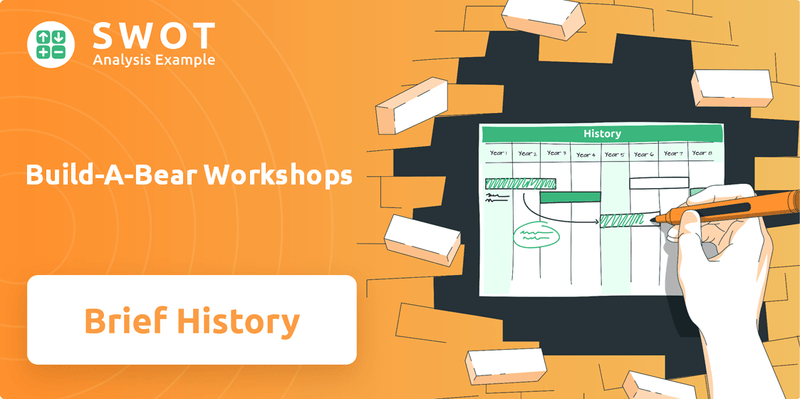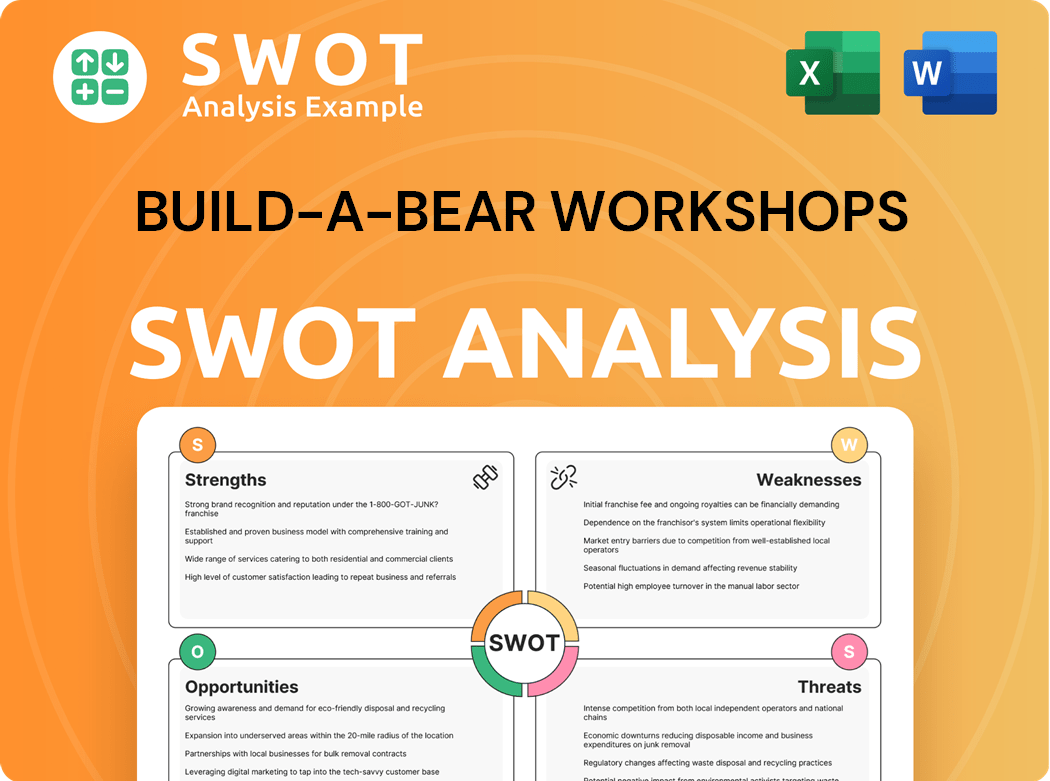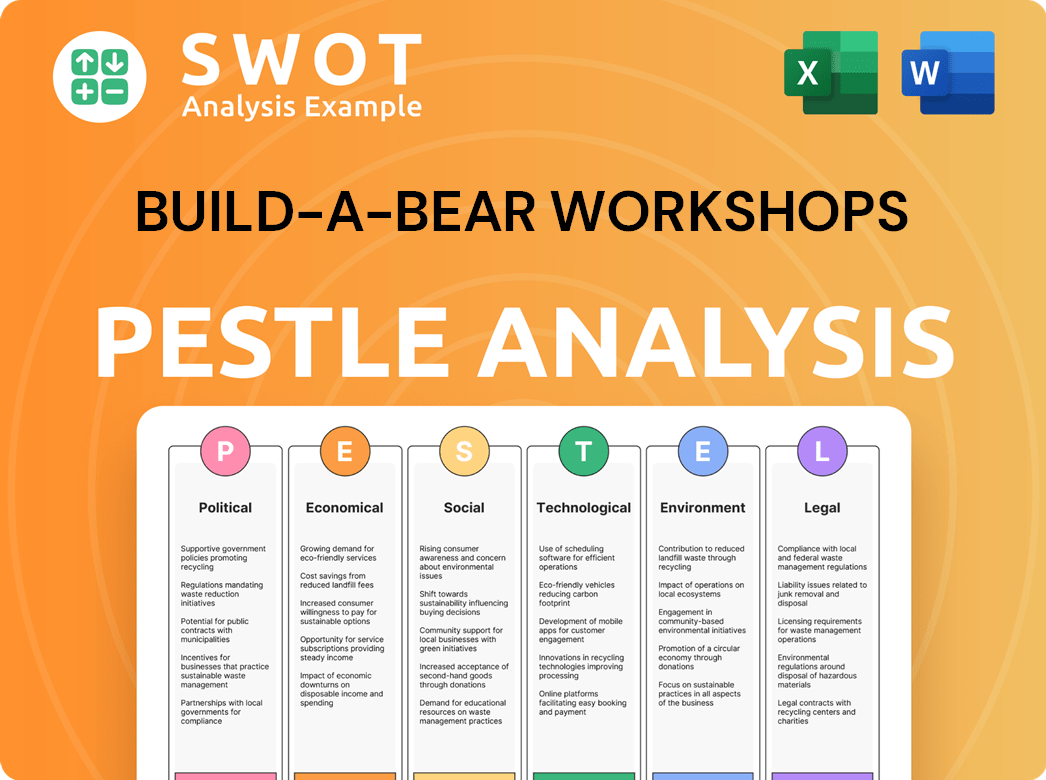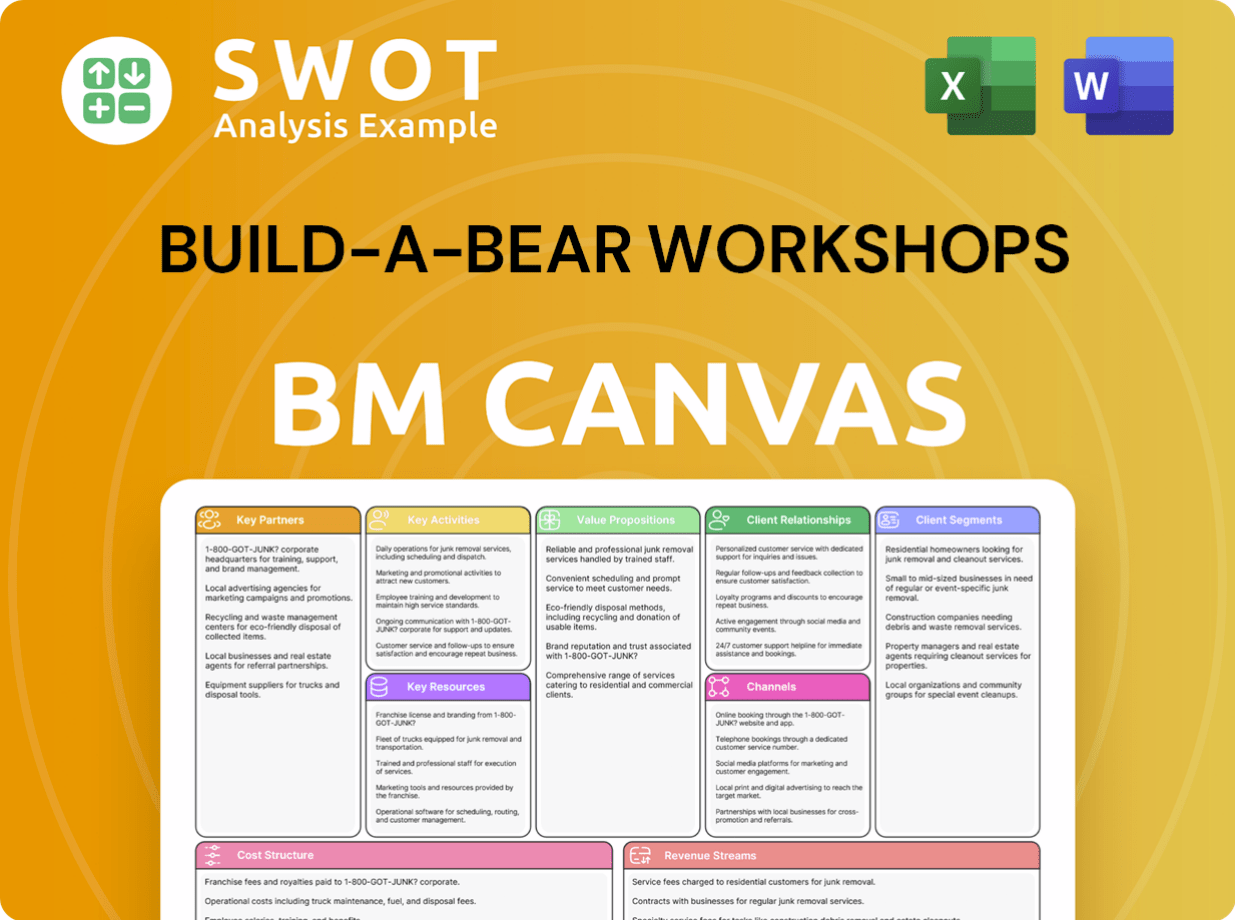Build-A-Bear Workshops Bundle
How did Build-A-Bear Workshop revolutionize the toy industry?
Step into the heartwarming world of Build-A-Bear Workshop, a company that transformed the retail landscape with its innovative approach to toys. From its humble beginnings in 1997, Build-A-Bear created a unique, interactive experience centered around customizable stuffed animals, allowing customers to actively participate in the creation process. This pivotal shift moved beyond mere purchasing, offering a memorable and personalized journey for all ages.

Founded by Build-A-Bear founder Maxine Clark, the company's first store in St. Louis, Missouri, sparked a revolution in the toy market. Today, Build-A-Bear Workshop boasts nearly 600 interactive brick-and-mortar locations worldwide, alongside a robust e-commerce presence. This Build-A-Bear history reveals how the company evolved from a simple concept into a multi-generational brand, adapting to challenges and embracing new opportunities.
What is the Build-A-Bear Workshops Founding Story?
The Build-A-Bear Workshop story began on October 26, 1997, in St. Louis, Missouri. The Build-A-Bear history is one of innovation in the retail sector, focusing on interactive experiences. The company quickly became known for its unique approach to selling plush toys.
Build-A-Bear Workshop was founded by Maxine Clark. Her extensive experience in retail management, including her time as president of Payless ShoeSource, played a crucial role in the company's early success. Clark's vision was to create a retail environment that offered a hands-on, engaging experience for children, a concept inspired by her own childhood memories.
The initial challenge was the lack of personalized, experiential retail options for children. Clark's solution was the workshop model, where customers actively participate in the design and assembly of their stuffed animals. This approach offered both a high-profit margin product and an exciting experience. The original business model included the interactive process of choosing a plush, stuffing it, personalizing it with outfits and accessories, and giving it a heart and name. The initial plan also included doll shops, known as Build-A-Doll.
The Build-A-Bear Workshop concept was chosen by children.
- Maxine Clark presented three business plans to children, who chose the 'build-a-bear' concept.
- Before the first store opened, Clark secured all necessary copyrights and trademarks.
- Clark left her position at Payless in January 1996 to pursue the venture.
- The company found success during the dot-com era by focusing on its unique experiential model.
One interesting aspect of the company's inception is that Clark presented three business plans to a panel of children, who chose the 'build-a-bear' concept. From the start, Clark planned for the Build-A-Bear to be a retail chain, securing all necessary copyrights and trademarks before the first store opened. Clark resigned from Payless in January 1996 to pursue this entrepreneurial venture. The company's establishment occurred during the dot-com era, a challenging time for retailers, yet Build-A-Bear thrived by focusing on its unique experiential model. For more information about the company's target audience, you can read about the Target Market of Build-A-Bear Workshops.
Build-A-Bear Workshops SWOT Analysis
- Complete SWOT Breakdown
- Fully Customizable
- Editable in Excel & Word
- Professional Formatting
- Investor-Ready Format

What Drove the Early Growth of Build-A-Bear Workshops?
The early years of Build-A-Bear Workshop were marked by rapid growth and expansion. The innovative retail concept quickly gained traction, leading to significant store openings and market penetration. This early success set the stage for the company's continued evolution and impact on the toy industry. Learn more about the Mission, Vision & Core Values of Build-A-Bear Workshops.
The first Build-A-Bear Workshop store in St. Louis generated approximately $400,000 in sales within its first four months. This strong performance attracted venture capital, enabling the opening of ten new Build-A-Bear stores in 1999. This rapid expansion highlighted the market's positive response to the interactive stuffed animal creation experience, a key element of the Build-A-Bear Workshop business model.
International expansion began in 2003 with the opening of stores in Canada and England. By February 2025, Build-A-Bear had a global presence with 589 locations. This included adding over 100 locations in the past two years, demonstrating a strategic move beyond the U.S. market and showcasing the Build-A-Bear Workshop expansion strategy.
In fiscal year 2024 alone, Build-A-Bear opened 64 new corporate- and partner-operated stores and entered 10 new countries, expanding its reach to over 25 countries. Approximately 35% of Build-A-Bear stores are now in tourist and non-traditional locations. This diversification included partnerships with Carnival Cruise Lines, Great Wolf Lodge, and Landry's, adapting to changing retail trends.
The company's growth strategy heavily relies on an 'asset-light' partner-operated model. This approach enhances profitability and cash flow with minimal operating capital risk, a key factor in the Build-A-Bear Workshop success story. This model has been instrumental in sustaining growth and profitability.
Build-A-Bear Workshops PESTLE Analysis
- Covers All 6 PESTLE Categories
- No Research Needed – Save Hours of Work
- Built by Experts, Trusted by Consultants
- Instant Download, Ready to Use
- 100% Editable, Fully Customizable

What are the key Milestones in Build-A-Bear Workshops history?
The journey of Build-A-Bear Workshop company history is marked by significant milestones, demonstrating its growth and adaptability in the retail sector. From its inception, the company has achieved several key objectives, solidifying its position in the market.
| Year | Milestone |
|---|---|
| 2001 | Named Retail Innovator of the Year by the National Retail Federation, recognizing its interactive retail model. |
| 2002 | Celebrated the 100th anniversary of the teddy bear while opening its 100th store, showcasing rapid expansion. |
| 2024 | Launched the 'The Stuff You Love' campaign, marking over a quarter-century of creating memories. |
Build-A-Bear has consistently introduced innovative strategies to enhance customer engagement and expand its brand presence. These innovations have helped the company adapt to changing consumer preferences and market trends.
Build-A-Bear expanded its brand beyond physical retail by creating engaging content through social media channels. This strategy helped in reaching a broader audience and enhancing brand visibility.
The company established Build-A-Bear Entertainment, a subsidiary focused on digital content creation and outbound licensing. This diversification allowed for new revenue streams and brand extensions.
In 2018, Build-A-Bear launched Build-A-Bear Radio, which became available on iHeart Radio in 2019, producing music and podcasts. This initiative provided additional avenues for customer engagement.
In early 2024, Build-A-Bear launched its Mini Beans collection, hand-held furry friends priced under $10. This collection saw a 30% year-over-year expansion in Q1 2025, contributing to sales growth.
Despite its successes, Build-A-Bear has faced challenges, particularly in adapting to evolving consumer behaviors and market dynamics. Addressing these issues has been crucial for the company's sustained growth.
The company had to adapt to the decline in traditional mall relevancy and changing consumer shopping habits. This required strategic shifts in retail footprint and online presence.
Disparate warehousing and financial systems initially restricted inventory data visibility, impacting growth. The company undertook a digital transformation to address these inefficiencies.
In fiscal 2024, Build-A-Bear achieved its fourth consecutive year of record revenues and pretax income, with total revenues reaching $496.4 million and pretax income of $67.1 million. The company reported record-breaking first-quarter results in fiscal 2025, with total revenues of $128.4 million, an 11.9% increase, and pretax income of $19.6 million, a 30.6% increase.
Build-A-Bear Workshops Business Model Canvas
- Complete 9-Block Business Model Canvas
- Effortlessly Communicate Your Business Strategy
- Investor-Ready BMC Format
- 100% Editable and Customizable
- Clear and Structured Layout

What is the Timeline of Key Events for Build-A-Bear Workshops?
The Build-A-Bear Workshop has a rich history, marked by significant milestones from its inception. Founded in 1997 by Maxine Clark, the company opened its first store in St. Louis, Missouri. It quickly gained momentum, attracting venture capital and expanding its store count. The company has continued to innovate and adapt to market trends, expanding internationally and diversifying its offerings, including digital and entertainment ventures.
| Year | Key Event |
|---|---|
| 1997 | Maxine Clark founded the company, opening the first store in St. Louis, Missouri. |
| 1999 | Attracted venture capital, leading to the opening of ten new stores. |
| 2001 | Named Retail Innovator of the Year by the National Retail Federation. |
| 2002 | Celebrated the 100th anniversary of the teddy bear and opened its 100th store. |
| 2003 | Began international expansion with locations in Canada and England. |
| 2013 | Sharon Price John became President and CEO, initiating strategic repositioning and digital transformation. |
| 2018 | Launched Build-A-Bear Radio. |
| 2019 | Partnered with Warner Music Group for a music label and started Build-A-Bear Entertainment. |
| 2020 (Spring) | Relocated global headquarters to downtown St. Louis. |
| 2024 (Early) | Launched the Mini Beans collection. |
| 2024 (Mid) | Rebranded with a new slogan: 'The Stuff You Love'. |
| 2024 (Fiscal Year End February 1, 2025) | Reported record total revenues of $496.4 million. |
| 2025 (March) | Announced a 10% increase in quarterly dividend to $0.22 per share. |
| 2025 (March) | Announced plans for a new, multi-level retail experience at ICON Park in Orlando, Florida, set to open in 2026. |
| 2025 (Q1 Fiscal Year End May 3, 2025) | Reported record first-quarter results with total revenues of $128.4 million, an 11.9% increase, and pre-tax income of $19.6 million, a 30.6% increase. |
| 2025 (Fiscal Year) | Expects net new unit growth of at least 50 experience locations, primarily partner-operated international stores. |
The company anticipates mid-single-digit percentage revenue growth in fiscal 2025. This projection builds on the record revenues of $496.4 million reported in the fiscal year ending February 1, 2025. The growth strategy focuses on expanding experiences and commercial revenue.
Updated pre-tax income guidance for fiscal 2025 is in the range of $61 million to $67 million. This reflects the company’s focus on efficient operations and strategic investments. The first-quarter results for 2025 showed a pre-tax income of $19.6 million.
The company plans to add at least 50 net new experience locations in 2025. A significant portion of this expansion will be through partner-operated international stores. This strategy aims to broaden Build-A-Bear's global footprint.
Capital expenditures for fiscal 2025 are projected to be between $20 million and $25 million. These investments support the company's expansion plans and enhance existing locations. This includes the new multi-level experience in Orlando, set to open in 2026.
Build-A-Bear Workshops Porter's Five Forces Analysis
- Covers All 5 Competitive Forces in Detail
- Structured for Consultants, Students, and Founders
- 100% Editable in Microsoft Word & Excel
- Instant Digital Download – Use Immediately
- Compatible with Mac & PC – Fully Unlocked

Related Blogs
- What is Competitive Landscape of Build-A-Bear Workshops Company?
- What is Growth Strategy and Future Prospects of Build-A-Bear Workshops Company?
- How Does Build-A-Bear Workshops Company Work?
- What is Sales and Marketing Strategy of Build-A-Bear Workshops Company?
- What is Brief History of Build-A-Bear Workshops Company?
- Who Owns Build-A-Bear Workshops Company?
- What is Customer Demographics and Target Market of Build-A-Bear Workshops Company?
Disclaimer
All information, articles, and product details provided on this website are for general informational and educational purposes only. We do not claim any ownership over, nor do we intend to infringe upon, any trademarks, copyrights, logos, brand names, or other intellectual property mentioned or depicted on this site. Such intellectual property remains the property of its respective owners, and any references here are made solely for identification or informational purposes, without implying any affiliation, endorsement, or partnership.
We make no representations or warranties, express or implied, regarding the accuracy, completeness, or suitability of any content or products presented. Nothing on this website should be construed as legal, tax, investment, financial, medical, or other professional advice. In addition, no part of this site—including articles or product references—constitutes a solicitation, recommendation, endorsement, advertisement, or offer to buy or sell any securities, franchises, or other financial instruments, particularly in jurisdictions where such activity would be unlawful.
All content is of a general nature and may not address the specific circumstances of any individual or entity. It is not a substitute for professional advice or services. Any actions you take based on the information provided here are strictly at your own risk. You accept full responsibility for any decisions or outcomes arising from your use of this website and agree to release us from any liability in connection with your use of, or reliance upon, the content or products found herein.